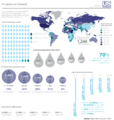Water footprint facts for kids
A water footprint is like a measure of how much freshwater we use. It shows the total amount of water used by people, groups, or companies to create the things we buy and the services we use every day. This includes everything from the food we eat to the clothes we wear, and even the electricity that powers our homes.
We can calculate a water footprint for almost anything – a single person, a family, a school, or even a whole country! It helps us understand how much water is used and sometimes polluted when we make things or do activities. While a water footprint is a good way to see how much water an organization uses and pollutes, it doesn't always show how other water sources are affected. More studies are needed to fully understand its impact on our planet's water.
Contents
What is a Water Footprint?
A water footprint helps us see the total amount of freshwater used to produce goods and services. Think about your favorite T-shirt. It took water to grow the cotton, dye the fabric, and make the shirt. All that water adds up to its water footprint!
Types of Water Footprints
There are different ways to look at a water footprint:
- Green water footprint: This is the amount of rainwater that is stored in the soil and used by plants. It's mostly about farming.
- Blue water footprint: This is the amount of surface water (like rivers and lakes) or groundwater that is taken and used. It's often used for irrigation, industries, and homes.
- Grey water footprint: This is the amount of freshwater needed to clean up pollution caused by making a product. It shows how much water is needed to dilute pollutants so they don't harm the environment.
Why is it Important?
Understanding water footprints helps us see how much water we use and where it comes from. It also shows us how our actions can affect water supplies around the world.
Saving Water
Knowing the water footprint of different products can help us make smarter choices. For example, some foods or clothes use a lot more water to produce than others. By choosing products with smaller water footprints, we can help save water.
Global Water Use
Many products we use every day are made in different countries. This means that our water footprint can spread across the globe. For instance, if you drink coffee, the water used to grow those coffee beans might be in a faraway country. This shows how connected we all are through water.
How the Idea Started
The idea of a water footprint was first introduced in 2002 by a scientist named A.Y. Hoekstra. He wanted a better way to measure how much water we use, beyond just looking at how much water comes out of our taps.
Later, other scientists helped to make the idea even clearer and developed ways to calculate water footprints. In 2008, a group of experts created the Water Footprint Network. This group works to share knowledge and develop new ways to understand and reduce our water use.
Images for kids
See also
 In Spanish: Huella hídrica para niños
In Spanish: Huella hídrica para niños




